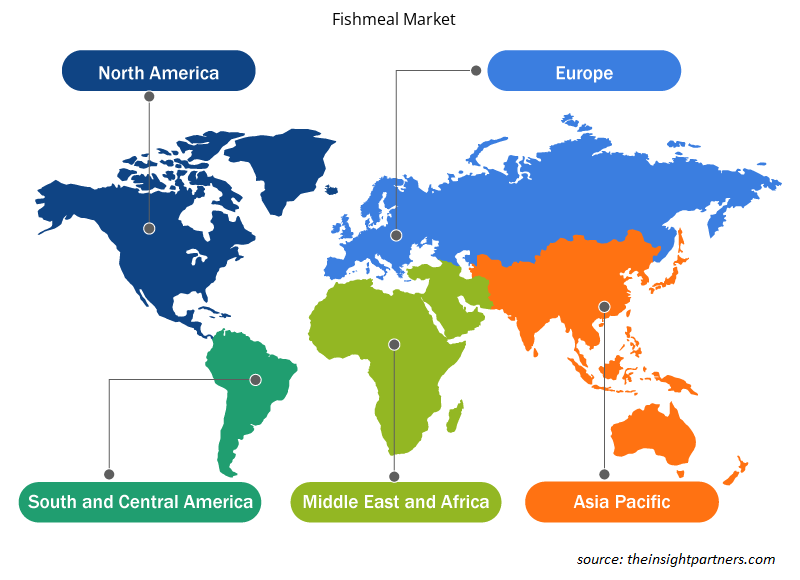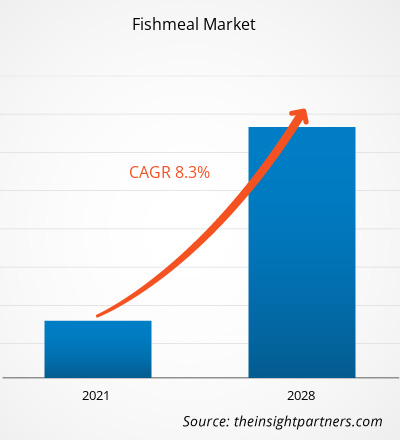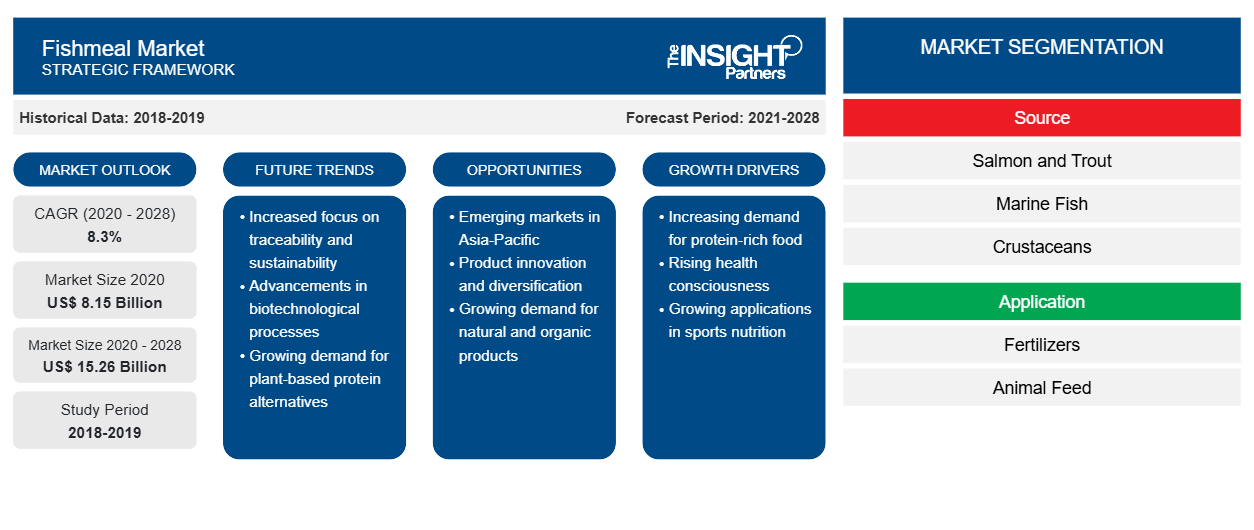Le marché de la farine de poisson a été évalué à 8 153,6 millions de dollars américains en 2020 et devrait atteindre 15 264,6 millions de dollars américains d'ici 2028 ; il devrait croître à un TCAC de 8,3 % de 2021 à 2028.
La farine de poisson est produite à partir de sous-produits de poisson provenant des industries de transformation alimentaire et de filetage. Elle est principalement utilisée comme ingrédient à haute teneur en protéines (60 à 72 %) dans les aliments destinés aux animaux d'élevage et aux espèces aquacoles. La demande en farine de poisson dépasse l'offre ; par conséquent, l'industrie de l'alimentation animale a considérablement modifié la composition de la farine de poisson dans les aliments. Le marché de la farine de poisson a connu une croissance au cours de la période historique en raison du développement de l'aquaculture en raison de la demande croissante de produits de la mer et de la dépendance croissante des pays en développement à l'égard de l'aquaculture pour résoudre la pénurie alimentaire. En outre, la farine de poisson est durable par nature car elle est produite à partir de déchets d'autres industries. Par conséquent, elle fait partie de divers programmes de conservation de l'environnement. Le marché bénéficie ainsi de pratiques durables, telles que l'agriculture biologique.
En 2020, l'Asie-Pacifique détenait la plus grande part des revenus du marché mondial de la farine de poisson . En outre, la région devrait enregistrer le TCAC le plus élevé au cours de la période de prévision. L'Asie-Pacifique comprend plusieurs grandes économies telles que l'Inde, la Chine, le Japon, la Corée du Sud et l'Australie. Ces pays connaissent une recrudescence de l'industrialisation du secteur alimentaire et des activités d'urbanisation, offrant de nombreuses opportunités aux principaux acteurs du marché de la farine de poisson. L'Asie-Pacifique devrait connaître une demande croissante de farine de poisson dans les années à venir en raison de la présence de nombreux acteurs nationaux de petite et moyenne taille sur le marché. Au cours de la période de prévision, le marché de la farine de poisson devrait connaître une énorme demande de la part des industries de l'aquaculture et de l'agriculture biologique en raison de son profil hautement nutritif contenant des acides aminés essentiels. En outre, la farine de poisson trouve des applications dans les industries nutraceutiques, pharmaceutiques et autres. Le marché de la farine de poisson en Asie-Pacifique devrait croître au cours de la période de prévision en raison de l'énorme croissance du secteur de l'aquaculture, en particulier en Inde et en Chine. De plus, la croissance démographique et le soutien croissant du gouvernement stimulent la croissance du marché dans la région.
Personnalisez ce rapport en fonction de vos besoins
Vous bénéficierez d'une personnalisation gratuite de n'importe quel rapport, y compris de certaines parties de ce rapport, d'une analyse au niveau des pays, d'un pack de données Excel, ainsi que de superbes offres et réductions pour les start-ups et les universités.
-
Obtenez les principales tendances clés du marché de ce rapport.Cet échantillon GRATUIT comprendra une analyse de données, allant des tendances du marché aux estimations et prévisions.
La pandémie de COVID-19 a eu un impact négatif sur l'industrie de la pêche, avec des perturbations dans sa chaîne d'approvisionnement. La baisse de la demande de fruits de mer a entraîné une diminution de la production de poisson. La faible demande de poisson a réduit les activités de la flotte de pêche, ce qui a eu un impact négatif sur la production de sous-produits de la pêche, en particulier de farine de poisson. Cependant, avec le lancement de campagnes de vaccination à l'échelle mondiale, les économies reprennent et les industries constatent une demande pour leurs produits. Divers gouvernements prennent également des initiatives pour minimiser les pertes de l'industrie de la pêche dues à cette pandémie. Grâce à cela, le marché de la farine de poisson devrait connaître une croissance dans les années à venir.fishmeal. However, with the launch of vaccination drives globally, the economies are reviving, and industries are witnessing demand for their products. Various governments are also taking initiatives to minimize the loss of the fisheries industry due to this pandemic. With this, the fishmeal market is expected to witness growth in the coming years.
Informations sur le marché
Demande croissante d'aliments pour animaux riches en protéines
L'industrialisation de l'élevage a augmenté la demande d'ingrédients alimentaires riches en protéines pour animaux afin d'augmenter le taux de conversion alimentaire. Le bétail élevé industriellement est principalement nourri avec des concentrés à base de protéines de céréales et de légumes, comme les tourteaux de soja, pour les aider à prendre du poids et à produire une viande riche en protéines. Les animaux d'élevage dépendent des protéines et d'autres éléments comme éléments constitutifs essentiels à leur croissance. Les protéines contenues dans les aliments pour animaux sont une excellente source d'énergie et d'acides aminés essentiels, tels que la lysine et la méthionine. La prise de conscience croissante des bienfaits des protéines pour la santé animale a créé une demande substantielle pour divers aliments protéiques, tels que les farines de protéines animales, les farines de plumes, la farine de poisson, la farine d'os et la farine de sang. La farine de poisson est une riche source de protéines, de minéraux et d'acides gras et est facilement digérée par le bétail lors de la consommation. La farine de poisson de haute qualité permet la formulation de régimes alimentaires riches en nutriments pour le bétail, favorisant ainsi sa croissance optimale. Le bétail et les animaux d'élevage contribuant de manière significative à la chaîne d'approvisionnement alimentaire mondiale, la demande d'aliments pour animaux nutritifs riches en protéines augmente et devrait se poursuivre au cours de la période de prévision. La demande croissante d’aliments pour animaux riches en protéines pour favoriser la croissance du bétail à tous les stades de la vie stimule considérablement le marché global de la farine de poisson.lysine and methionine. The growing awareness about the health benefits of proteins on animal health has created a substantial demand for various protein feeds, such as animal protein meals, feather meals, fishmeal, bone meal, and blood meal. Fishmeal is a rich source of protein, minerals, and fatty acids and is easily digested by the livestock upon consumption. High-quality fishmeal enables the formulation of nutrient-dense livestock diets, promoting their optimal growth. As livestock and farm animals contribute significantly to the global food supply chain, the demand for protein-rich nutritious animal feed is rising and is expected to continue during the forecast period. The constantly burgeoning demand for protein-rich animal feeds to promote growth in livestock at all stages of life is driving the overall fishmeal market substantially.
Informations sur les sources
Selon la source, le marché mondial de la farine de poisson est segmenté en saumon, maquereau, anchois, capelan et autres. En 2020, le segment des anchois représentait la plus grande part des revenus. Les anchois se trouvent principalement en SAM, en particulier au Pérou. Le volume de production de farine de poisson fabriquée à partir d'anchois péruviens équivaut aux besoins de la moitié de la production mondiale de poissons d'élevage nourris. Le marché du segment des anchois devrait connaître une croissance au cours de la période de prévision en raison de la disponibilité des anchois en grande quantité. La grande disponibilité des anchois a également un impact positif sur la sécurité alimentaire mondiale.fishmeal market is segmented into salmon, mackerel, anchovy, capelin, and others. In 2020, the anchovy segment accounted for the largest revenue share. Anchovies are majorly found in SAM, especially in Peru. The volume of fishmeal production manufactured from Peruvian anchovies is equivalent to the requirement of half of the global fed farmed fish production. The market for the anchovy segment is expected to witness growth during the forecast period due to the availability of anchovies in ample quantity. The high availability of anchovies also has a positive impact on the global food security.
Informations sur les applications
En fonction des applications, le marché mondial de la farine de poisson est segmenté en aliments pour animaux, agriculture et autres. En 2020, le segment des aliments pour animaux représentait la plus grande part des revenus. La farine de poisson est un ingrédient alimentaire hautement digestible, contenant une grande quantité d'énergie par unité de poids. Elle contient peu de glucides et constitue une excellente source de vitamines, de minéraux, d'huiles (lipides) et de protéines. De nombreuses farines de poisson commerciales sont fabriquées à partir de petits poissons osseux, qui ne conviennent pas à la consommation humaine ou sont fabriquées à partir de sous-produits de l'industrie de transformation du poisson. Par conséquent, la valorisation des sous-produits rend l'alimentation animale à base de farine de poisson économique. Par conséquent, l'amélioration de l'alimentation animale à l'aide de farine de poisson stimule la croissance du marché pour ce segment.fishmeal market is segmented into animal feed, agriculture, and others. In 2020, the animal feed segment accounted for the largest revenue share. Fishmeal is a highly digestible feed ingredient, carrying a high amount of energy per unit weight. It contains little carbohydrate and is an excellent source of vitamins, minerals, oils (lipids), and proteins. Many commercial fishmeal are made from small and bony fishes, which are not suitable for consumption by human or manufactured from by-products of the fish processing industry. Therefore, the valorization of by-products makes the fishmeal animal feed economical. Hence, the enhancement of animal feed with the help of fishmeal is driving the market growth for this segment.
TripleNine, The Scoular Company, FF SKAGEN A/S, Pelagia AS, Soytex LTD, Pesquera Diamante SA, TASA, Oceana Group Limited, Omega Protein Corporation et COPEINCA sont quelques-uns des acteurs bien établis sur le marché mondial de la farine de poisson. Les entreprises du marché adoptent des stratégies telles que le développement de produits, l'agrandissement d'usines et les fusions et acquisitions pour étendre leur présence dans le monde entier et répondre à la demande croissante des utilisateurs finaux. Par exemple, en septembre 2021, Scoular a lancé une nouvelle marque Encompass pour son activité croissante de farine de poisson., The Scoular Company, FF SKAGEN A/S, Pelagia AS, Soytex LTD, Pesquera Diamante S.A., TASA, Oceana Group Limited, Omega Protein Corporation, and COPEINCA are a few well-established players in the global fishmeal market. Companies in the market are adopting strategies such as product developments, plant expansions, and mergers and acquisitions to expand their footprint worldwide and meet the growing demand from end users. For instance, in September 2021, Scoular launched a new brand Encompass for its growing fishmeal business.
Aperçu régional du marché de la farine de poisson Market Regional Insights
Les tendances régionales et les facteurs influençant le marché de la farine de poisson tout au long de la période de prévision ont été expliqués en détail par les analystes d’Insight Partners. Cette section traite également des segments et de la géographie du marché de la farine de poisson en Amérique du Nord, en Europe, en Asie-Pacifique, au Moyen-Orient et en Afrique, ainsi qu’en Amérique du Sud et en Amérique centrale.Fishmeal Market throughout the forecast period have been thoroughly explained by the analysts at Insight Partners. This section also discusses Fishmeal Market segments and geography across North America, Europe, Asia Pacific, Middle East and Africa, and South and Central America.

- Obtenez les données régionales spécifiques au marché de la farine de poisson
Portée du rapport sur le marché de la farine de poisson
| Attribut de rapport | Détails |
|---|---|
| Taille du marché en 2020 | 8,15 milliards de dollars américains |
| Taille du marché d'ici 2028 | 15,26 milliards de dollars américains |
| Taux de croissance annuel composé mondial (2020-2028) | 8,3% |
| Données historiques | 2018-2019 |
| Période de prévision | 2021-2028 |
| Segments couverts |
Par source
|
| Régions et pays couverts |
Amérique du Nord
|
| Leaders du marché et profils d'entreprises clés |
|
Densité des acteurs du marché de la farine de poisson : comprendre son impact sur la dynamique commerciale
Le marché de la farine de poisson connaît une croissance rapide, tirée par la demande croissante des utilisateurs finaux en raison de facteurs tels que l'évolution des préférences des consommateurs, les avancées technologiques et une plus grande sensibilisation aux avantages du produit. À mesure que la demande augmente, les entreprises élargissent leurs offres, innovent pour répondre aux besoins des consommateurs et capitalisent sur les tendances émergentes, ce qui alimente davantage la croissance du marché.
La densité des acteurs du marché fait référence à la répartition des entreprises ou des sociétés opérant sur un marché ou un secteur particulier. Elle indique le nombre de concurrents (acteurs du marché) présents sur un marché donné par rapport à sa taille ou à sa valeur marchande totale.
Les principales entreprises opérant sur le marché de la farine de poisson sont :
- TripleNeuf
- La Compagnie Scoular
- FF SKAGEN A/S
- Pélagie AS
- Soytex Ltée
Avis de non-responsabilité : les sociétés répertoriées ci-dessus ne sont pas classées dans un ordre particulier.

- Obtenez un aperçu des principaux acteurs du marché de la farine de poisson
Rapports en vedette
- Tendances progressives de l'industrie sur le marché mondial de la farine de poisson pour aider les acteurs à développer des stratégies efficaces à long terme
- Stratégies de croissance des entreprises adoptées par les marchés développés et en développement
- Analyse quantitative du marché mondial de la farine de poisson de 2019 à 2028
- Estimation de la demande de farine de poisson dans diverses industries
- Développements récents pour comprendre le scénario concurrentiel du marché et la demande de farine de poisson
- Tendances et perspectives du marché associées aux facteurs qui stimulent et freinent la croissance du marché de la farine de poisson
- Processus de prise de décision en comprenant les stratégies qui sous-tendent l'intérêt commercial à l'égard de la croissance du marché mondial de la farine de poisson
- Taille du marché de la farine de poisson à différents nœuds du marché
- Aperçu détaillé et segmentation du marché mondial de la farine de poisson ainsi que de sa dynamique dans l'industrie
- Taille du marché de la farine de poisson dans diverses régions avec des opportunités de croissance prometteuses
Marché de la farine de poisson, par source
- Saumon
- Maquereau
- Anchois
- Capelan
- Autres
Marché de la farine de poisson, par application
Profils d'entreprise
- TripleNeuf
- La Compagnie Scoular
- FF SKAGEN A/S
- Pélagie AS
- Soytex Ltée
- Pêcheur Diamant SA
- TASA
- Groupe Oceana Limitée
- Société de protéines Omega
- COPEINCA
- Analyse historique (2 ans), année de base, prévision (7 ans) avec TCAC
- Analyse PEST et SWOT
- Taille du marché Valeur / Volume - Mondial, Régional, Pays
- Industrie et paysage concurrentiel
- Ensemble de données Excel
Rapports récents
Témoignages
Raison d'acheter
- Prise de décision éclairée
- Compréhension de la dynamique du marché
- Analyse concurrentielle
- Connaissances clients
- Prévisions de marché
- Atténuation des risques
- Planification stratégique
- Justification des investissements
- Identification des marchés émergents
- Amélioration des stratégies marketing
- Amélioration de l'efficacité opérationnelle
- Alignement sur les tendances réglementaires























 Obtenez un échantillon gratuit pour - Marché de la farine de poisson
Obtenez un échantillon gratuit pour - Marché de la farine de poisson